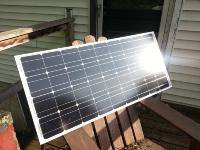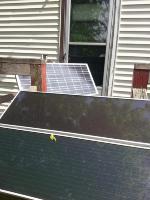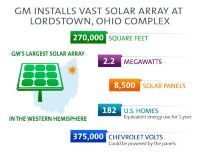You are using an out of date browser. It may not display this or other websites correctly.
You should upgrade or use an alternative browser.
You should upgrade or use an alternative browser.
Anyone running solar powered stuff at home?
- Thread starter MannDude
- Start date
drmike
100% Tier-1 Gogent
Sun is out and re-poisitioned the panel. It's getting good sun now.
The old back porch mount job. That's a field test setup. You need proper mounting before a breeze sends those flying. Never lost one in the wind, but they can and will catch air. Had to fetch some once as a storm rolled in and it wasn't fun. With these, glass will get broken and that's about all she wrote for the panel if so. Be forewarned.
Optimally the panels should be away from the house and not under trees. The house blocks light this time of year until probably a tad past noon into 1PM. The sun gets quickly overhead and best energy to capture is meh, 11AM-2PM. Problem is you are missing the 11-1PM due to house. The later sun this time of year you are cutting at angle with the 100W panel.
100W panel, that's facing EAST with some south emphasis correct?
The 2 15W panels, those are directly south facing correct?
The gig with placement (and placement is a PITA) is to get the best quality and shortest path for sun onto the panels. You want clear total sun cover on the panels. Some panels really get odd if some cells are in shade. I see trees reflected on the 15W panel, meaning late afternoon into evening sun on the south side is useless for solar.
The 100W panel would do well on a solar tracker. There are a bunch of DIY builds or you can buy expensive. A tracker repositions the panel throughout the day (it moves).
drmike
100% Tier-1 Gogent
There is really very little to learn with systems like Mann is tinkering with. Same applies to most solar builds until you amass lots of watts and get into stacking controllers, stacking batteries, AC conversion, etc.Anyone have any good quick-start guide to just start reading and get acquainted with this? Not planning on purchasing anything really but just want to know the equations and logic behind it all.
Or is it just basic electrical engineering?
As-is in this thread, if you've ever worked with 12VDC power (think your automobile) you are good to go.
Literally builds like this are:
Solar panel + solar mounting hardware + wire to connect that to a solar controller + wire to connect controller to 12V battery + wire to connect 12V device to power (could be inverter, could be PC, could be lighting, etc.).
There isn't much to export to a computer from a solar energy system. It's just in order of importance:Charge controller being used is the same as what came with the kit. It'll work for now however I'll eventually want to replace it with something better as I want one that will visually display more information about what is going on. I feel like some also have phone apps or a local web interface (think router configuration) that will let you view what is happening on your PC and export the info as well.
- Battery voltage
- Capture watts currently
- Current watts being drawn (demand)
All other stats data can be deduced / calculated from a pool of those numbers.
Controller you have is capable. It's no frills and probably $10 in China or less. That said, it's a great bargain. I have a fried "good" often referred to solar controller. It's a 40A controller (so more A ability than yours) but it was oh $300+. Worth it? Nope. Would I buy a pricey controller again? Only if buying something for a BIG system in Kw size.
There are likely sub $100 controllers with data point collection output. I haven't ever seen the need for more sissy tech to complicate things.
What you do need and missing from that controller is a meter to see current voltage of the battery. What I did was this:
- Buy an automotive lighter socket with male end. They sell these for putting more sockets in cars. They are dividers - one end goes into lighter socket, other end has 1-3 female socket ends. $10~.
- Buy an LCD voltage meter. Simple little import item and tons of them out there. Buy one for automotive use with cigarette lighter plug on the end. $10 tops.
- Cut the male end off the automotive lighter socket in step 1. Strip the positive and negative wires.
- Place the wires into controller on demand/load section. Or alternatively, just wire those two wires directly to battery terminals on the battery.
- At this point you have socket divider wired up, now plug the LCD voltage meter in step 2 into your new female lighter socket. Should come on and give you battery voltage.
There are battery and tracking of power modules you can in-line wire that exist for RC contraptions. I have one boxed on shelf waiting for system redev. They'll do what above does plus a bunch more.
With the meters and modules herein, one has to come up with a switch or other way of turning them off. Constant phantom draw going on with such. Really you only need to check battery and other data when you do. Rest of the time, blah.
They're located where they're located at for several reasons. I was originally going to place them out in the yard, however would have to:The old back porch mount job. That's a field test setup. You need proper mounting before a breeze sends those flying. Never lost one in the wind, but they can and will catch air. Had to fetch some once as a storm rolled in and it wasn't fun. With these, glass will get broken and that's about all she wrote for the panel if so. Be forewarned.
Optimally the panels should be away from the house and not under trees. The house blocks light this time of year until probably a tad past noon into 1PM. The sun gets quickly overhead and best energy to capture is meh, 11AM-2PM. Problem is you are missing the 11-1PM due to house. The later sun this time of year you are cutting at angle with the 100W panel.
100W panel, that's facing EAST with some south emphasis correct?
The 2 15W panels, those are directly south facing correct?
The gig with placement (and placement is a PITA) is to get the best quality and shortest path for sun onto the panels. You want clear total sun cover on the panels. Some panels really get odd if some cells are in shade. I see trees reflected on the 15W panel, meaning late afternoon into evening sun on the south side is useless for solar.
The 100W panel would do well on a solar tracker. There are a bunch of DIY builds or you can buy expensive. A tracker repositions the panel throughout the day (it moves).
A.) Build a mount
B.) Buy more cable or make one and splice Renogy's proprietary ends with the extended cable
C.) Worry about theft
I know the setup is not as optimal as it could be. In fact, Indiana is a pretty bad place for solar to begin with and the trees outback doesn't make it better. They only get a few hours of good light each day on days it isn't overcast.
As mentioned, it's just a tinkering/fun/learning/hobby project. As needed and as time and money allows it's quite likely I'll optimize it, but it will serve the purpose I want as it sits now.
drmike
100% Tier-1 Gogent
Geez that's a big installation. Didn't realize GM was deploying solar installs this size.Not personally, but I do know my work place installed a huge array of solar panels last fall.
The Solar Pi lives! http://imgur.com/a/3Y14g
Images are large so didn't embed them in here. It's pretty ghetto but it works. Not as efficient as a setup as it could be, but it works. Will monitor usage over the course of the next few days and see how practical it is.
Images are large so didn't embed them in here. It's pretty ghetto but it works. Not as efficient as a setup as it could be, but it works. Will monitor usage over the course of the next few days and see how practical it is.
That is pretty cool! I need to start playing around with this stuff as well.The Solar Pi lives! http://imgur.com/a/3Y14g
Images are large so didn't embed them in here. It's pretty ghetto but it works. Not as efficient as a setup as it could be, but it works. Will monitor usage over the course of the next few days and see how practical it is.
drmike
100% Tier-1 Gogent
It's good setup for experimenting. What you have is what most people start with. Many never exceed this setup. My builds are only a tad more complicated. Some fuses going on, big blocking diodes on my pedal generator...The Solar Pi lives! http://imgur.com/a/3Y14g
Images are large so didn't embed them in here. It's pretty ghetto but it works. Not as efficient as a setup as it could be, but it works. Will monitor usage over the course of the next few days and see how practical it is.
Need inline fuse(s) or DC panel long term for load and safety. Can quick and cheap make a DC bus bar for wiring things or clamp post connections.
Look up DC buck converters ($10?) and drop the AC inverter for the Pi. Going DC --> DC-AC inverter --> AC-DC wall wart 5VDC. Those conversions are unnecessary, lossy and the inverter is almost surely square sine, which puts a beating on electronic components.
I'd get everything up out of the basement, except batteries. Put power where you are, not where convenient for running indoors. Its a simple hole with a drill bit.
WWW Hosting Services
New Member
I used to run my RaspberryPi from solar panels on my window seal. It was pretty cool... it would charge the built in battery during the day and run the RaspberryPi, then during the night it would manage to just about last on the battery. Once every few weeks I'd find it off in the morning where it must have ran out. Was great! Ran a media server 100% green 
Last edited by a moderator:
drmike
100% Tier-1 Gogent
How many watts of solar and how many amp hours in that battery?I used to run my RaspberryPi from solar panels on my window seal. It was pretty cool... it would charge the built in battery during the day and run the RaspberryPi, then during the night it would manage to just about last on the battery. Once every few weeks I'd find it off in the morning where it must have ran out. Was great! Ran a media server 100% green
SaadIsmail
New Member
Also want to know watts of solar, already have few of 12v 14A batteries lying around & that solar thing will be awesome to play with after the examsHow many watts of solar and how many amp hours in that battery?
Normal batteries (from a car, for example) wont be any good. You need deep cycle batteries.Also want to know watts of solar, already have few of 12v 14A batteries lying around & that solar thing will be awesome to play with after the exams
drmike
100% Tier-1 Gogent
SLA - Sealed Lead Acids should work fine also. There are other battery types that will work fine also. Depends on the controller you are using though and what is supported by it.Normal batteries (from a car, for example) wont be any good. You need deep cycle batteries.
And the reason why automotive batteries normally found under the bonnet aren't sufficient is due to their need to have high CCAs - cold cranking amps - lots of power needed at once to start the engine. They are optimized for that mass burst and not for long steady or low continuous draws.
WWW Hosting Services
New Member
How many watts of solar and how many amp hours in that battery?
My stepdad had a big box type of battery laying in the loft and set it up for me. I wasn't too sure on solar panels and electricity storing but he works for a power company and set it up.Also want to know watts of solar, already have few of 12v 14A batteries lying around & that solar thing will be awesome to play with after the exams
Indeed, however, really you should be using deep cycle batteries if you're putting any kind of load on them. Normal batteries (all car batteries included) aren't designed for deep cycle and will very quickly wear out if drained below 80% capacity (some a lot higher). Anything less than 70% will usually kill a battery stone dead to the point it wont take a charge at all - it just slowly drains away. The controller has little to no effect on that until you talk about charging - PWM vs MPPT. Ideally you want MPPT but for cheap installs that run little load then PWM is fine.SLA - Sealed Lead Acids should work fine also. There are other battery types that will work fine also. Depends on the controller you are using though and what is supported by it.
drmike
100% Tier-1 Gogent
Even the cheap controllers these days are doing far more on charging intelligence. MPPT I have on my busted Morningstar controller. That's approach of the pricey controllers still.Indeed, however, really you should be using deep cycle batteries if you're putting any kind of load on them. Normal batteries (all car batteries included) aren't designed for deep cycle and will very quickly wear out if drained below 80% capacity (some a lot higher). Anything less than 70% will usually kill a battery stone dead to the point it wont take a charge at all - it just slowly drains away. The controller has little to no effect on that until you talk about charging - PWM vs MPPT. Ideally you want MPPT but for cheap installs that run little load then PWM is fine.
The dead battery issue happens all over - even on 1.2 / 1.5V cells (AA/AAA). Chargers have expected voltages and when you get beneath such they just treat it as a dead cell. You can actually wire a matching cell to such and trickle energy into the below voltage cell so the charger later will recognize it as alright. Been doing this trick for decades as deep discharge happens accidentally at times.
Batteries - all of them - are fairly horrendous, regardless of chemistry.
Anyone care to speak kindly of a brand of batteries they use and have been reliable?
Never use cheap controllers, they gonna fuck up your battery.
A lot of fake controllers on ebay and stuff.
When you buy a expensive deep cycle battery for lets say 80AH which cost you at least 200$ you dont want to use a cheap controller.
I used Longex and had no problems, for my new mini solarplant i got a Multipower.
A lot of fake controllers on ebay and stuff.
When you buy a expensive deep cycle battery for lets say 80AH which cost you at least 200$ you dont want to use a cheap controller.
I used Longex and had no problems, for my new mini solarplant i got a Multipower.
Just installed my first this weekend - Some motion sensor flood lights I put outside on the shed that has an external solar panel and charge cable for it. Charges a mini battery non stop, so you have endless night light in case of motion. Its 'great! think it cost a whopping $15 at walmart. Made by Westinghouse.



